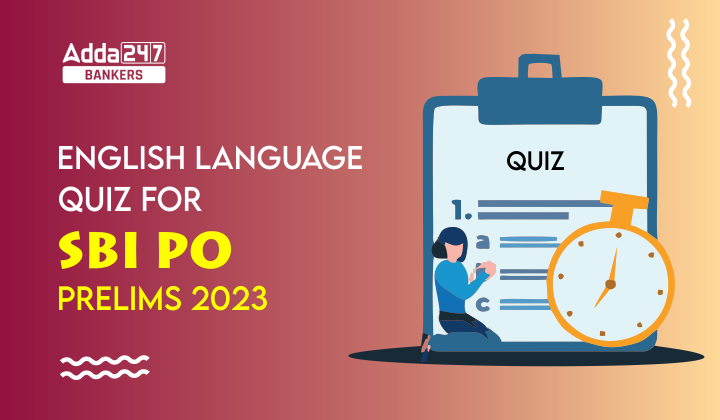Directions (1-10): Read the following passage, divided into number of paragraphs, carefully and answer the questions given below it. Certain words are given in bold to help you locate them while answering some of the questions.
Paragraph 1: In recent research, we investigated the impact of rainfall shocks on educational outcomes for children aged in-utero to 16, in rural India (Drought of Opportunities: Contemporaneous and Long-Term Impacts of Rainfall Shocks on Human Capital, 2017). We obtained data on simple literacy and numeracy test scores for over two million children tested between 2005 and 2009 for the Annual Status of Education Report (ASER) by non-governmental organization Pratham. This data set has test scores on children who have never enrolled, who are currently enrolled, and who have dropped out of school.
Paragraph 2: We matched the ASER data to rainfall measures from weather stations all over India. We used rainfall as a proxy for agricultural productivity, which allowed us to separate the effects of productivity from other differences across places. Because we had observations of rainfall and test scores for each district over many years, we could measure within-district differences between good, bad and normal rainfall years. By accounting for both district-specific effects (some places just have higher test scores than others), and year-specific effects (test scores might be getting better or worse over time), we could be sure of isolating the effect of rainfall, and its underlying effects on productivity, on human capital investment.
Paragraph 3: We found that children who experienced droughts early in life score lower on tests and are less likely to be enrolled in school. This is consistent with previous literature (Under the Weather: Health, Schooling, and Economic Consequences of Early-Life Rainfall by Sharon L. Maccini and Dean Yang, 2009, and Killing Me Softly: The Fetal Origins Hypothesis by Douglas Almond and Janet Currie, 2011). What we found next surprised us. For older children, when rainfall (and therefore, the prevailing wage) is higher, test scores, attendance, and enrolment decrease. A positive rainfall shock increases wages by 2% and decreases math test scores by 1-6%, decreases school attendance by 2 percentage points, and decreases the probability that a child is enrolled in school by 1 percentage point. This implies that a positive rainfall shock increases the urban-rural enrolment gap by 15% for 5-16-year-olds.
Paragraph 4: To look into what children are doing with their time, we turned to another large household survey in India, the National Sample Survey (NSS). Matching this survey to the rainfall data helped confirm our hypothesis—we observed that children are less likely to report school as their primary activity when rains are good, and more likely to do so during droughts. They are more likely to report wage labour, work at home (on farms or in other businesses) and domestic work as their primary activity when rainfall is abundant. It appears households are responding to higher wages by either having children work in agriculture themselves, or fill in for adults at home while they work. The increased opportunity cost of schooling affects the families’ decision to invest in education.
Paragraph 5: Taken together, the results for early life and older children make sense. The extra income and food supply generated during a good harvest is especially important during the in-utero period and for infants and young children whose brains are still developing. Babies and toddlers are also too young to be of help on the farm or at home, so the substitution effect is not relevant for them. Hence, the income effect dominates. As a child gets older, the relative benefits of nutrition for cognitive ability decrease, while schooling and other time-intensive activities like studying become important in overall test scores. Moreover, they can now be productive in agriculture and at home. Hence, wages increase and labour is in high demand, schooling may take a back seat to farm and/or domestic work for poor families.
Q1. How according to the author, the recent research on impact of rainfall shocks helps in determining educational outcomes for children as mentioned in Paragraph 1?
(I)The research would provide an exact report of long-term impacts of rainfall on crops.
(II)The final data by Annual Status of Education Report (ASER) would provide test scores on children who have never enrolled, who are currently enrolled, and who have dropped out of school.
(III)The report would help in obtaining data on simple literacy especially of children up to 16 years of age in rural India.
(a)Only (I) is correct
(b)Only (II) is correct
(c)Both (II) and (III) are correct
(d)Both (I) and (III) are correct
(e)All are correct
Q2. Why according to the passage, the rainfall was used as a proxy for agricultural productivity as mentioned in Paragraph 2?
(I)It allowed in separating the effects of productivity from other differences across places in the country.
(II)Since with help of observations of rainfall and test scores for each district over many years it was easy to measure within-district differences between good, bad and normal rainfall years.
(III)By accounting for both district-specific effects and year-specific effects, it was possible to isolate the effect of rainfall, and its underlying effects on productivity, on human capital investment.
(a)Only (I) is correct
(b)Only (II) is correct
(c)Only (III) is correct
(d)Both (II) and (III) are correct
(e)All are correct
Q3. Which of the following statements is not true in context of the paragraph 3?
(a)It was found that children who experienced droughts early in life score lower on tests and are less likely to be enrolled in school.
(b)For older children, when rainfall (and therefore, the prevailing wage) is higher, test scores, attendance, and enrolment decrease.
(c) A positive rainfall shock increases the urban-rural enrolment gap by 15% for 5-16-year-olds.
(d) A positive rainfall shock increases school attendance by 2 percentage points, and decreases the probability that a child is enrolled in school by 5 percentage point.
(e)All are true.
Q4. What are the major outcomes after tallying the rainfall data and survey conducted by National Sample Survey (NSS) as mentioned in Paragraph 4?
(I) It is observed that children are less likely to report school as their primary activity when rains are good, and more likely to do so during droughts.
(II) It is observed that households are responding to higher wages by either having children work in agriculture themselves, or fill in for adults at home while they work.
(III) It is realized that the increased opportunity cost of schooling affects the families’ decision to invest in education.
(a)Only (I) is correct
(b)Only (II) is correct
(c)Only (III) is correct
(d)Both (I) and (II) are correct
(e)All are correct
Q5. How according to the author income effect prevails over substitution effect as mentioned in Paragraph 5?
(I) During the in-utero period and for infants and young children whose brains are still developing are too young to be of help on the farm or at home.
(II) As a child gets older, they can be engaged at the school and thus there is a decrement in wages and demand of labour for poor families.
(III) The results for early life and older children have the desired effect of increasing household income, along with the opportunity cost of time-intensive investments like schooling.
(a)Only (I) is correct
(b)Only (II) is correct
(c)Both (I) and (II) are correct
(d)Both (II) and (III) are correct
(e)All are correct
Q6. Which one of the following is the most appropriate title for the given passage?
(a) Impact of rainfall shocks on education outcomes.
(b) Why a good monsoon leads to bad scores in agriculture exams
(c) Agricultural Volatility and Investments in Children
(d) Economic Consequences of Early-Life Rainfall
(e) Collaboration of rainfall data, ASER and NSS
Q7. Choose the correct synonym for the word “Contemporaneous” highlighted in the passage.
(a)History
(b)Existent
(c)Incident
(d)Coetaneous
(e)Satellite
Q8. Choose the correct synonym for the word “Proxy” highlighted in the passage.
(a)Behest
(b)Surrogate
(c)Precept
(d)Injunction
(e)License
Q9. Choose the correct antonym for the word “Abundant” highlighted in the passage.
(a)Copious
(b)Thorough
(c)Competent
(d)Sparse
(e)Exact
Q10. Choose the correct antonym for the word “Cognitive” highlighted in the passage.
(a)Subjective
(b)Reasonable
(c)Logical
(d)Lucid
(e)Physical
Solutions
S1. Ans. (c)
Sol. Read the first paragraph carefully, both the points (II) and (III) are clearly mentioned, determining the impact of rainfall shocks on educational outcomes for children. Hence, (c) is the correct option in context of the paragraph.
S2. Ans. (e)
Sol. Read the second paragraph carefully, all the statements are explained in the paragraph. Hence, (e) is the correct option.
S3. Ans. (d)
Sol. Refer the sentence in the third paragraph, “A positive rainfall shock increases wages by 2% and decreases math test scores by 1-6%, decreases school attendance by 2 percentage points, and decreases the probability that a child is enrolled in school by 1 percentage point.” Hence, sentence (d) is incorrect in context of the paragraph.
S4. Ans. (e)
Sol. Read the fourth paragraph carefully, all three statements are clearly mentioned there. Hence, (e) is the correct option.
S5. Ans. (a)
Sol. Read the last paragraph of the passage carefully, it can be easily inferred from there that only statement (I) explains the domination of income effect over substitution effect.
The author’s argument is that the income effect is more important than the substitution effect for infants and young children because they are too
young to be of help on the farm or at home. This means that the extra income and food supply generated during a good harvest is more likely to be used to improve their nutrition and health, rather than to buy other goods or services.
Hence, (a) is the correct choice.
S6. Ans. (a)
Sol. Read the whole passage carefully, it can be inferred that the complete passage talks about the impact of rainfall shocks on education outcomes in rural India. Hence, (a) is the most apt title for the given passage.
S7. Ans. (d)
Sol. Contemporaneous means existing at or occurring in the same period of time; contemporary. Coetaneous means having the same age or date of origin; contemporary. Hence, both are similar in meanings.
(a) History: The study of past events, particularly human affairs, and the events themselves as they have occurred in the past.
(b) Existent: Something that exists or is real; it is currently present or in existence.
(c) Incident: An event or occurrence, often a minor or unexpected one, that may have some significance or impact.
(e) Satellite: In the context of celestial bodies, a satellite is a natural or artificial object that orbits a larger celestial body, such as a planet or a moon. In other contexts, a satellite can refer to a smaller entity or organization that is closely connected or dependent on a larger one.
S8. Ans. (b)
Sol. Proxy means the authority to represent someone else, especially in voting.
Surrogate means a substitute, especially a person deputizing for another in a specific role or office. Hence both are similar in meanings.
(a) Behest means a person’s orders or command.
(c) Precept means a general rule intended to regulate behaviour or thought.
(d) Injunction means an authoritative warning or order.
S9. Ans. (d)
Sol. Abundant means existing or available in large quantities; plentiful.
Sparse means scanty; in short supply. Hence both are opposite in meanings.
S10. Ans. (e)
Sol. Cognitive means concerning the mind; emotional. Hence, ‘Physical’ is the word most opposite in meaning to it.
Lucid means expressed clearly; easy to understand.





 English Language Quiz For Bank Foundatio...
English Language Quiz For Bank Foundatio...
 English Language Quiz For Bank Mains Exa...
English Language Quiz For Bank Mains Exa...







